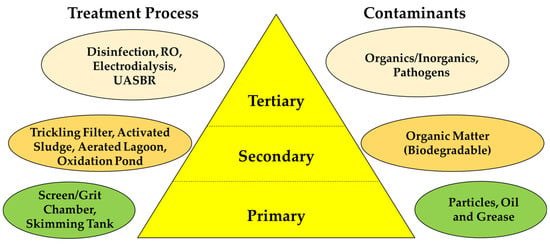You're using an outdated browser. Please upgrade to a modern browser for the best experience.
Please note this is a comparison between Version 1 by Md Shahinoor Islam and Version 2 by Sirius Huang.
The advancement in water treatment technology has revolutionized the progress of membrane bioreactor (MBR) technology in the modern era. The large space requirement, low efficiency, and high cost of the traditional activated sludge process have given the necessary space for the MBR system to come into action.
- membrane bioreactor (MBR)
- structural features
- sustainable water treatment
1. Introduction
In recent times, rapid industrial growth that is due to an ever-increasing population has caused an increase in demand for water [1][2][3][1,2,3]. The increase in the use of fresh water and discharging without adequate treatment poses a significant challenge to the world [4][5][4,5]. At present, there are two billion people who live in countries with water scarcity, and it is estimated that 25% of the children will be living in places with severe water scarcity by 2040, according to the United Nations Children’s Fund (UNICEF) [6]. Other than water scarcity, water pollution due to the discharge of industrial effluents has a significant impact on the environment [7][8][7,8]. As a result, there is a necessity of developing sustainable and efficient wastewater treatment technologies for better water cycle management and reuse [4]. The membrane bioreactor (MBR) has received attention in the past few decades as one of the promising technologies for wastewater treatment and reuse [9][10][11][9,10,11].
MBR is the process that combines biological treatment (aerobic, anaerobic) with membrane technology for the treatment of wastewater [12]. This process uses microfiltration or ultrafiltration for the separation of sludge produced by biological treatments instead of using a clarifier for gravity settling as in conventional biological treatments. In comparison to the conventional activated sludge (CAS) process, MBR offers several benefits. The solid retention time (SRT) in MBR is higher compared with CAS, whereas the hydraulic retention time (HRT) is lower in MBR than in the CAS process. Moreover, the separation of sludge is more efficient in the case of MBR. The effluent quality of MBR is much better in terms of biochemical oxygen demand (BOD), suspended solids, and turbidity, making it suitable for water reclamation and requiring less space [3][12][3,12]. Other than CAS, MBR can also be used in anaerobic treatments by replacing conventional anaerobic digestion by using an up-flow anaerobic sludge blanket (UASB), expanded granular sludge bed (EGSB), or anaerobic baffled tank reactor [13]. The anaerobic membrane bioreactor (AnMBR) can produce high-quality effluent with lower chemical oxygen demand (COD) compared with the conventional process by controlling the biomass concentration [13][14][13,14].
The MBR process was first introduced in 1969 by Dorr-Oliver Inc. However, the initial developments could not be translated to widespread industrial applications, owing to the large expenses associated with membrane material and energy [3][15][3,15]. Since then, further improvements in membrane materials, configurations, and process parameters have been made for its utilization in commercial applications. The development of MBR on a commercial scale has gained momentum since its application started in the treatment of industrial and municipal wastewater [16].
2. Water Treatment Stages in the Modern Age
At present, conventional wastewater treatment consists of three stages: primary, secondary, and tertiary (Figure 1).
Figure 1.
Different levels of wastewater treatment.
